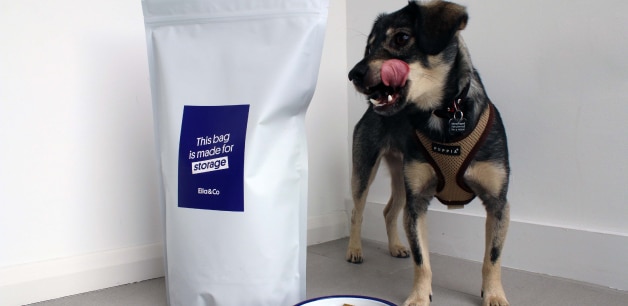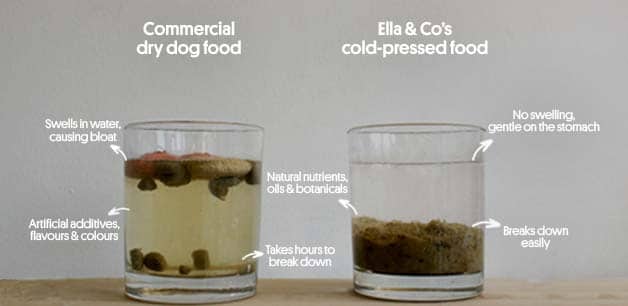Answering your questions about the latest dry dog food craze
Perhaps you’ve been researching how to feed your dog a healthy diet, and you’ve come across cold-pressed dog food. Cold-pressed is becoming increasingly popular, but you may be wondering what cold-pressing means, and how it can help your dog.
I was once in your shoes too. I wanted to develop an affordable diet for dogs that offers all of the great benefits as raw, whilst being convenient. One of my biggest beliefs is that it’s important for pet parents to know how their dog’s food is prepared. I wanted to provide you with some information about cold-pressed dog food, and how the food can benefit your dog for the better.

What does cold-pressing mean?
The term ‘cold-pressed’ refers to how the food is made:
1. To begin, our natural, nutritious ingredients are chopped into small pieces and mixed with water. We use water as an aid to bind the ingredients together.
2. This mix is gently pressed into pellet moulds at low temperatures, without any steam. Pressing removes most of the water used to initially mix the ingredients together, so what’s left is delicious cold-pressed dog food!
Cold-pressed dog food can be compared to lots of today’s food and drink items, such as fresh juices or oils. To achieve juice or oil, fruits or seeds are placed in a large hydraulic press. The ingredients are pressed quickly to remove as much liquid as possible. Cold-pressing dog food uses the same method, except the liquid is discarded and the end product is kept. The end product in our case consists of the natural ingredients, which have been gently bound together to form a convenient, easy-to-feed and healthy food for dogs.
Because the ingredients are pressed at low, gentle temperatures (42-47°C), the important nutrients and oils are retained in the food. This means there’s no need to spray additional artificial vitamins and minerals onto the food, unlike with commercial dry food diets.

What are the benefits of cold-pressed food?
Feeding your dog a healthy, nutritious diet will help to improve their overall health and wellbeing in lots of ways!
Gentle on sensitive tummies
Firstly, because cold-pressing uses very low temperatures, the food maintains a high nutritional value. It’s suitable for dogs of all ages, from puppies 4 weeks of age onwards, to senior dogs. The process of cold-pressing reduces bacteria levels in the food, which makes it perfect for puppies with delicate tummies. Lastly, unlike commercial dry kibble, the absence of unnecessary fillers and bulking agents in our cold-pressed food means reduced risks of poor digestion.
Suitable for dogs of all ages
Ella’s cold-pressed is suitable for dogs of all ages, from puppies four weeks of age onwards, to senior dogs. The food softens quickly in water, making it easy to chew and digest. This means it’s perfect for new puppy teeth and older dogs who might be prone to dental issues.
Fresh & convenient
Cold-pressed food doesn’t require any special storage. The food is stable at room temperature and can be stored in your kitchen cabinet. We make all of our products fresh, in small batches and all of our food makes its way to your dog’s bowl within 1-2 months of manufacture.
Great for fussy dogs
Ella’s cold-pressed food contains high-quality, human-grade ingredients and is nutritionally superior to standard kibble. Its natural aromas and rich meaty flavours are enticing, improving palatability and making it perfect for fussy eaters.
Healthy skin & coat
Because the process of cold-pressing uses very low temperatures, the food retains high levels of natural omega and essential oils. These help to hydrate the skin barrier, which keeps the coat soft, healthy and glossy. A healthy coat and skin means less irritation and scratching! Cold-pressing also prevents free-radicals forming in the food, which can be known to damage a dog’s skin, coat and metabolism.

How does cold-pressed food compare to commercial dry dog food?
You might be wondering how cold-pressed food differs from kibble – and most importantly, how it is better. It is not just the manufacturing process that sets cold-pressed apart from kibble, but the ingredients that are used too.
Commercial dry dog food
Commercial dry dog food is extruded using extremely high temperatures and pressure to form a hard biscuit, typically referred to as ‘kibble’. The problem with commercial extruded dry dog food is that unfortunately, the high temperatures destroy the natural nutrients and proteins. This requires the essential vitamins and minerals to be artificially sprayed back onto the food at the end.
While dogs can survive on kibble, they cannot thrive and it can damage the immune system over time. Digestion can also be affected by dry kibble, as it can swell in the stomach and take hours to break down. Dogs with sensitive tummies might display digestion issues such as vomiting and diarrhoea when fed kibble, as their body struggles to digest it.
Ella’s cold-pressed
Ella’s cold-pressed food retains all of the important nutrients, vitamins and minerals which occur naturally in the nutritious ingredients. Because of this, there is no need to spray artificial vitamins onto the food at the end.
Cold-pressed food is very gentle on the stomach. It digests naturally by breaking down from the outside in, rather than swelling in the stomach. This can be visualised by placing kibble and cold-pressed in separate glasses of water, and watching how the food reacts and breaks down. You might notice that the kibble starts to swell in size and floats to the top, whereas cold-pressed will break down from the outside and settle at the bottom of the glass.
Cold-pressed food is nutritionally dense and packed with wholesome, healthy ingredients. The food has a larger ‘calorie-density’, which means less food is often needed to be fed compared to kibble.
Our protein sources are natural and UK-sourced. We do not use meat ‘meal’ which is often used in commercial kibble diets. Meat meal is a highly processed protein powder, usually consisting of unknown animal derivatives. It is extremely unhealthy and holds very little to no nutritional value.

Now’s the perfect time to upgrade your dog’s diet to Ella’s cold-pressed!
I hope this blog has offered some useful information about how cold-pressed dog food is made, and more importantly how nutrition can play a huge role in your dog’s overall wellbeing. I understand that not everyone is able to feed their dog a raw diet. That’s why I set out to create a cost-effective alternative that provides your dog with many of the same nutritional benefits as raw food.
It’s important to make sure that you research the best food for your dog. Every dog is different, and the requirements for one can be different to another’s. If you need any more advice, or if you have any questions about Ella’s cold-pressed food, you can reach out to me at james@ella.co
James & Ella x
